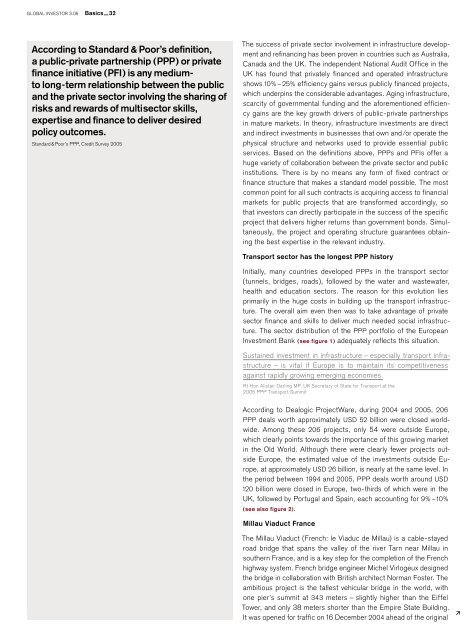Banking for 7 billion and 7 million
New challenges and opportunities of globalization Global Investor, 03/2006 Credit Suisse
New challenges and opportunities of globalization
Global Investor, 03/2006
Credit Suisse
You also want an ePaper? Increase the reach of your titles
YUMPU automatically turns print PDFs into web optimized ePapers that Google loves.
GLOBAL INVESTOR 3.06 Basics — 32<br />
According to St<strong>and</strong>ard & Poor’s definition,<br />
a public-private partnership (PPP) or private<br />
finance initiative (PFI) is any mediumto<br />
long-term relationship between the public<br />
<strong>and</strong> the private sector involving the sharing of<br />
risks <strong>and</strong> rewards of multisector skills,<br />
expertise <strong>and</strong> finance to deliver desired<br />
policy outcomes.<br />
St<strong>and</strong>ard & Poor’s PPP, Credit Survey 2005<br />
The success of private sector involvement in infrastructure development<br />
<strong>and</strong> refinancing has been proven in countries such as Australia,<br />
Canada <strong>and</strong> the UK. The independent National Audit Office in the<br />
UK has found that privately financed <strong>and</strong> operated infrastructure<br />
shows 10% – 25% efficiency gains versus publicly financed projects,<br />
which underpins the considerable advantages. Aging infrastructure,<br />
scarcity of governmental funding <strong>and</strong> the a<strong>for</strong>ementioned efficiency<br />
gains are the key growth drivers of public-private partnerships<br />
in mature markets. In theory, infrastructure investments are direct<br />
<strong>and</strong> indirect investments in businesses that own <strong>and</strong>/or operate the<br />
physical structure <strong>and</strong> networks used to provide essential public<br />
services. Based on the definitions above, PPPs <strong>and</strong> PFIs offer a<br />
huge variety of collaboration between the private sector <strong>and</strong> public<br />
institutions. There is by no means any <strong>for</strong>m of fixed contract or<br />
finance structure that makes a st<strong>and</strong>ard model possible. The most<br />
common point <strong>for</strong> all such contracts is acquiring access to financial<br />
markets <strong>for</strong> public projects that are trans<strong>for</strong>med accordingly, so<br />
that investors can directly participate in the success of the specific<br />
project that delivers higher returns than government bonds. Simultaneously,<br />
the project <strong>and</strong> operating structure guarantees obtaining<br />
the best expertise in the relevant industry.<br />
Transport sector has the longest PPP history<br />
Initially, many countries developed PPPs in the transport sector<br />
(tunnels, bridges, roads), followed by the water <strong>and</strong> wastewater,<br />
health <strong>and</strong> education sectors. The reason <strong>for</strong> this evolution lies<br />
primarily in the huge costs in building up the transport infrastructure.<br />
The overall aim even then was to take advantage of private<br />
sector finance <strong>and</strong> skills to deliver much needed social infrastructure.<br />
The sector distribution of the PPP portfolio of the European<br />
Investment Bank (see figure 1) adequately reflects this situation.<br />
Sustained investment in infrastructure – especially transport infrastructure<br />
– is vital if Europe is to maintain its competitiveness<br />
against rapidly growing emerging economies.<br />
Rt Hon Alistair Darling MP, UK Secretary of State <strong>for</strong> Transport at the<br />
2005 PPP Transport Summit<br />
According to Dealogic ProjectWare, during 2004 <strong>and</strong> 2005, 206<br />
PPP deals worth approximately USD 52 <strong>billion</strong> were closed worldwide.<br />
Among these 206 projects, only 54 were outside Europe,<br />
which clearly points towards the importance of this growing market<br />
in the Old World. Although there were clearly fewer projects outside<br />
Europe, the estimated value of the investments outside Europe,<br />
at approximately USD 26 <strong>billion</strong>, is nearly at the same level. In<br />
the period between 1994 <strong>and</strong> 2005, PPP deals worth around USD<br />
120 <strong>billion</strong> were closed in Europe, two-thirds of which were in the<br />
UK, followed by Portugal <strong>and</strong> Spain, each accounting <strong>for</strong> 9% –10%<br />
(see also figure 2).<br />
Millau Viaduct France<br />
The Millau Viaduct (French: le Viaduc de Millau) is a cable-stayed<br />
road bridge that spans the valley of the river Tarn near Millau in<br />
southern France, <strong>and</strong> is a key step <strong>for</strong> the completion of the French<br />
highway system. French bridge engineer Michel Virlogeux designed<br />
the bridge in collaboration with British architect Norman Foster. The<br />
ambitious project is the tallest vehicular bridge in the world, with<br />
one pier’s summit at 343 meters – slightly higher than the Eiffel<br />
Tower, <strong>and</strong> only 38 meters shorter than the Empire State Building.<br />
It was opened <strong>for</strong> traffic on 16 December 2004 ahead of the original

















